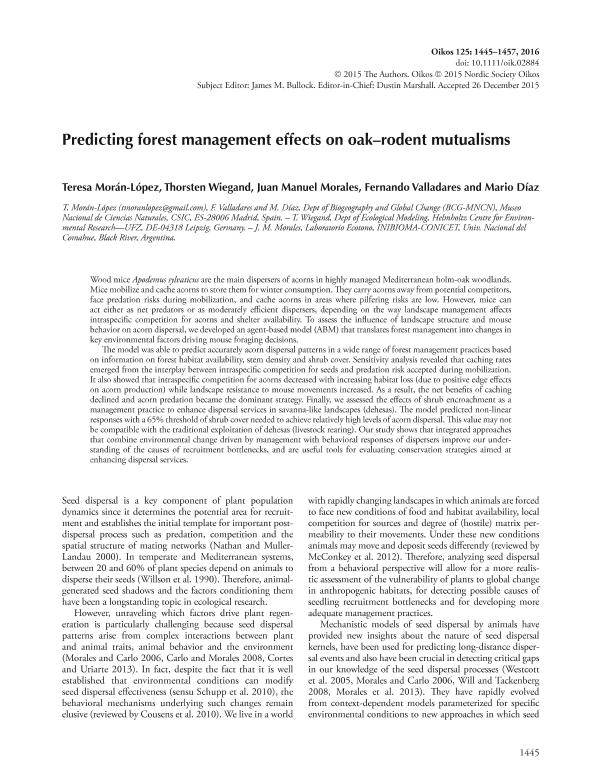Mostrar el registro sencillo del ítem
dc.contributor.author
Morán López, Teresa

dc.contributor.author
Wiegand, Thorsten

dc.contributor.author
Morales, Juan Manuel

dc.contributor.author
Valladares, Fernando
dc.contributor.author
Díaz, Mario
dc.date.available
2019-07-10T20:36:19Z
dc.date.issued
2016-10-30
dc.identifier.citation
Morán López, Teresa; Wiegand, Thorsten; Morales, Juan Manuel; Valladares, Fernando; Díaz, Mario; Predicting forest management effects on oak–rodent mutualisms; Wiley Blackwell Publishing, Inc; Oikos; 125; 10; 30-10-2016; 1445-1457
dc.identifier.issn
0030-1299
dc.identifier.uri
http://hdl.handle.net/11336/79335
dc.description.abstract
Wood mice Apodemus sylvaticus are the main dispersers of acorns in highly managed Mediterranean holm-oak woodlands. Mice mobilize and cache acorns to store them for winter consumption. They carry acorns away from potential competitors, face predation risks during mobilization, and cache acorns in areas where pilfering risks are low. However, mice can act either as net predators or as moderately efficient dispersers, depending on the way landscape management affects intraspecific competition for acorns and shelter availability. To assess the influence of landscape structure and mouse behavior on acorn dispersal, we developed an agent-based model (ABM) that translates forest management into changes in key environmental factors driving mouse foraging decisions. The model was able to predict accurately acorn dispersal patterns in a wide range of forest management practices based on information on forest habitat availability, stem density and shrub cover. Sensitivity analysis revealed that caching rates emerged from the interplay between intraspecific competition for seeds and predation risk accepted during mobilization. It also showed that intraspecific competition for acorns decreased with increasing habitat loss (due to positive edge effects on acorn production) while landscape resistance to mouse movements increased. As a result, the net benefits of caching declined and acorn predation became the dominant strategy. Finally, we assessed the effects of shrub encroachment as a management practice to enhance dispersal services in savanna-like landscapes (dehesas). The model predicted non-linear responses with a 65% threshold of shrub cover needed to achieve relatively high levels of acorn dispersal. This value may not be compatible with the traditional exploitation of dehesas (livestock rearing). Our study shows that integrated approaches that combine environmental change driven by management with behavioral responses of dispersers improve our understanding of the causes of recruitment bottlenecks, and are useful tools for evaluating conservation strategies aimed at enhancing dispersal services.
dc.format
application/pdf
dc.language.iso
eng
dc.publisher
Wiley Blackwell Publishing, Inc

dc.rights
info:eu-repo/semantics/openAccess
dc.rights.uri
https://creativecommons.org/licenses/by-nc-sa/2.5/ar/
dc.subject
Acorn Dispersal
dc.subject
Forest Management
dc.subject
Agent Based Model
dc.subject.classification
Ecología

dc.subject.classification
Ciencias Biológicas

dc.subject.classification
CIENCIAS NATURALES Y EXACTAS

dc.title
Predicting forest management effects on oak–rodent mutualisms
dc.type
info:eu-repo/semantics/article
dc.type
info:ar-repo/semantics/artículo
dc.type
info:eu-repo/semantics/publishedVersion
dc.date.updated
2019-01-23T19:03:28Z
dc.journal.volume
125
dc.journal.number
10
dc.journal.pagination
1445-1457
dc.journal.pais
Reino Unido

dc.journal.ciudad
Londres
dc.description.fil
Fil: Morán López, Teresa. Consejo Superior de Investigaciones Cientificas. Museo Nacional de Ciencias Naturales; España
dc.description.fil
Fil: Wiegand, Thorsten. Helmholtz Centre for Environmental Research; Alemania
dc.description.fil
Fil: Morales, Juan Manuel. Consejo Nacional de Investigaciones Científicas y Técnicas. Centro Científico Tecnológico Conicet - Patagonia Norte. Instituto de Investigaciones en Biodiversidad y Medioambiente. Universidad Nacional del Comahue. Centro Regional Universidad Bariloche. Instituto de Investigaciones en Biodiversidad y Medioambiente; Argentina. Universidad Nacional del Comahue. Centro Regional Universitario Bariloche. Laboratorio de Ecotono; Argentina
dc.description.fil
Fil: Valladares, Fernando. Consejo Superior de Investigaciones Cientificas. Museo Nacional de Ciencias Naturales; España
dc.description.fil
Fil: Díaz, Mario. Consejo Superior de Investigaciones Cientificas. Museo Nacional de Ciencias Naturales; España
dc.journal.title
Oikos

dc.relation.alternativeid
info:eu-repo/semantics/altIdentifier/url/https://onlinelibrary.wiley.com/doi/abs/10.1111/oik.02884
dc.relation.alternativeid
info:eu-repo/semantics/altIdentifier/doi/http://dx.doi.org/10.1111/oik.02884
Archivos asociados
